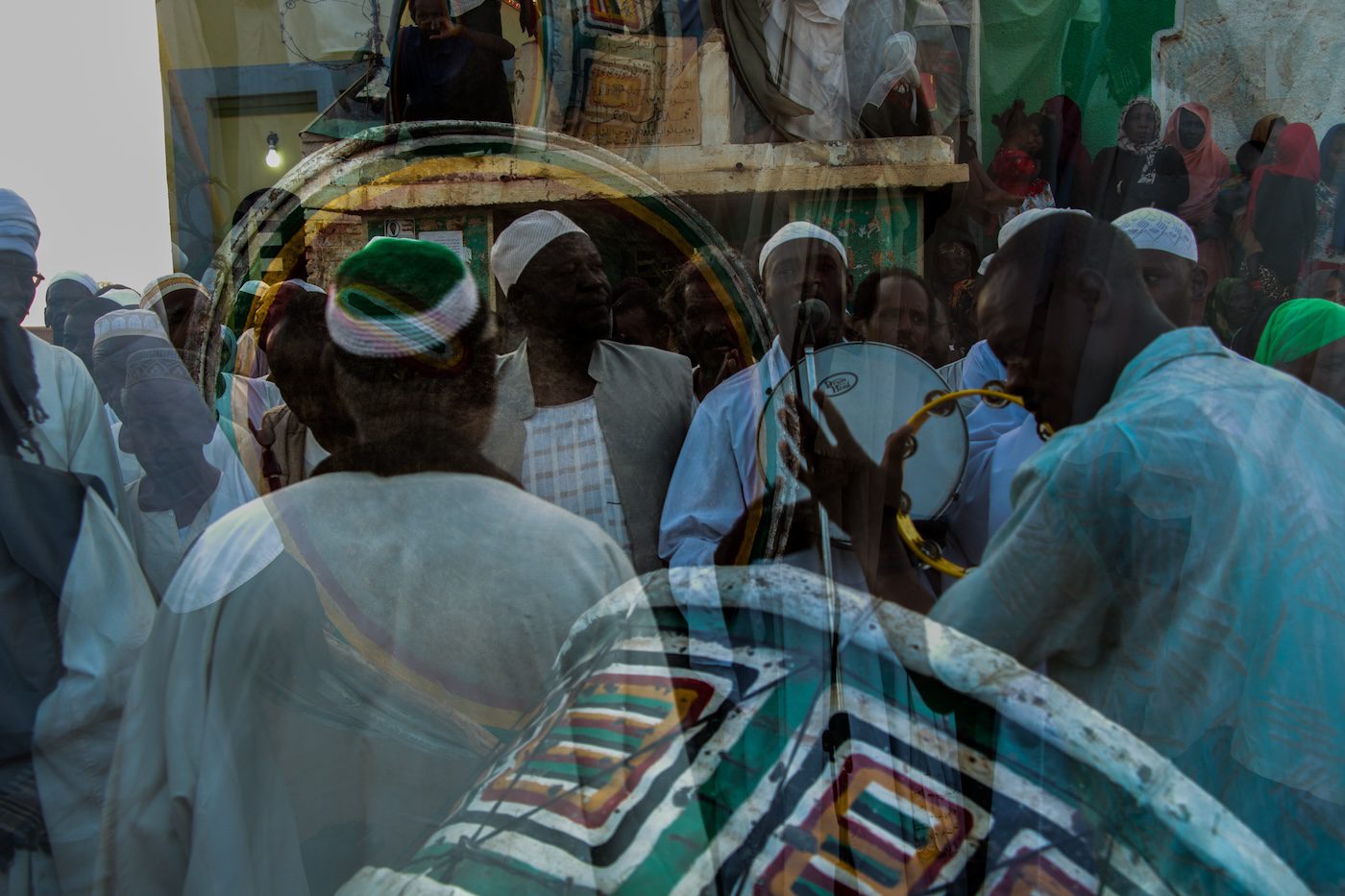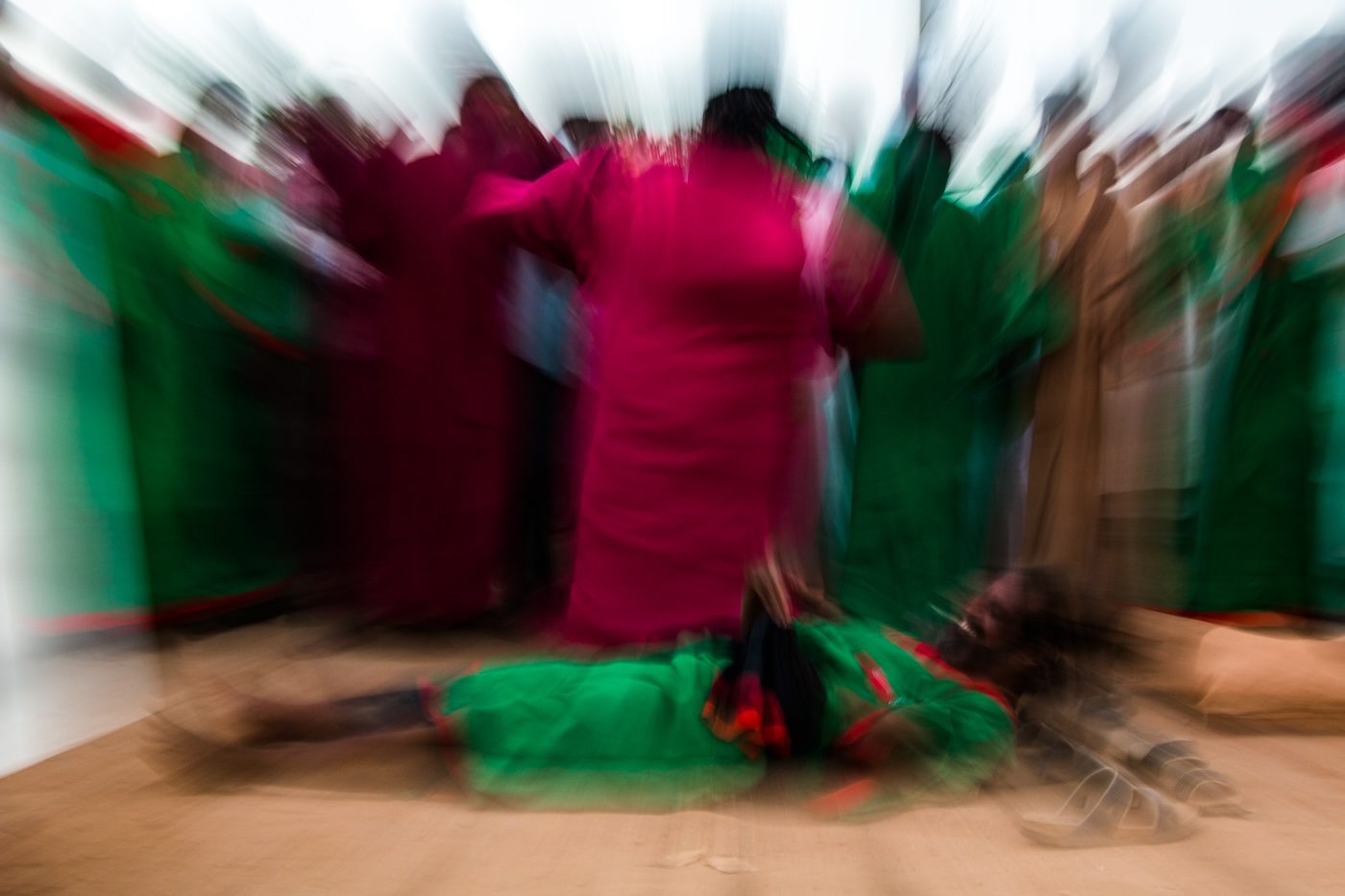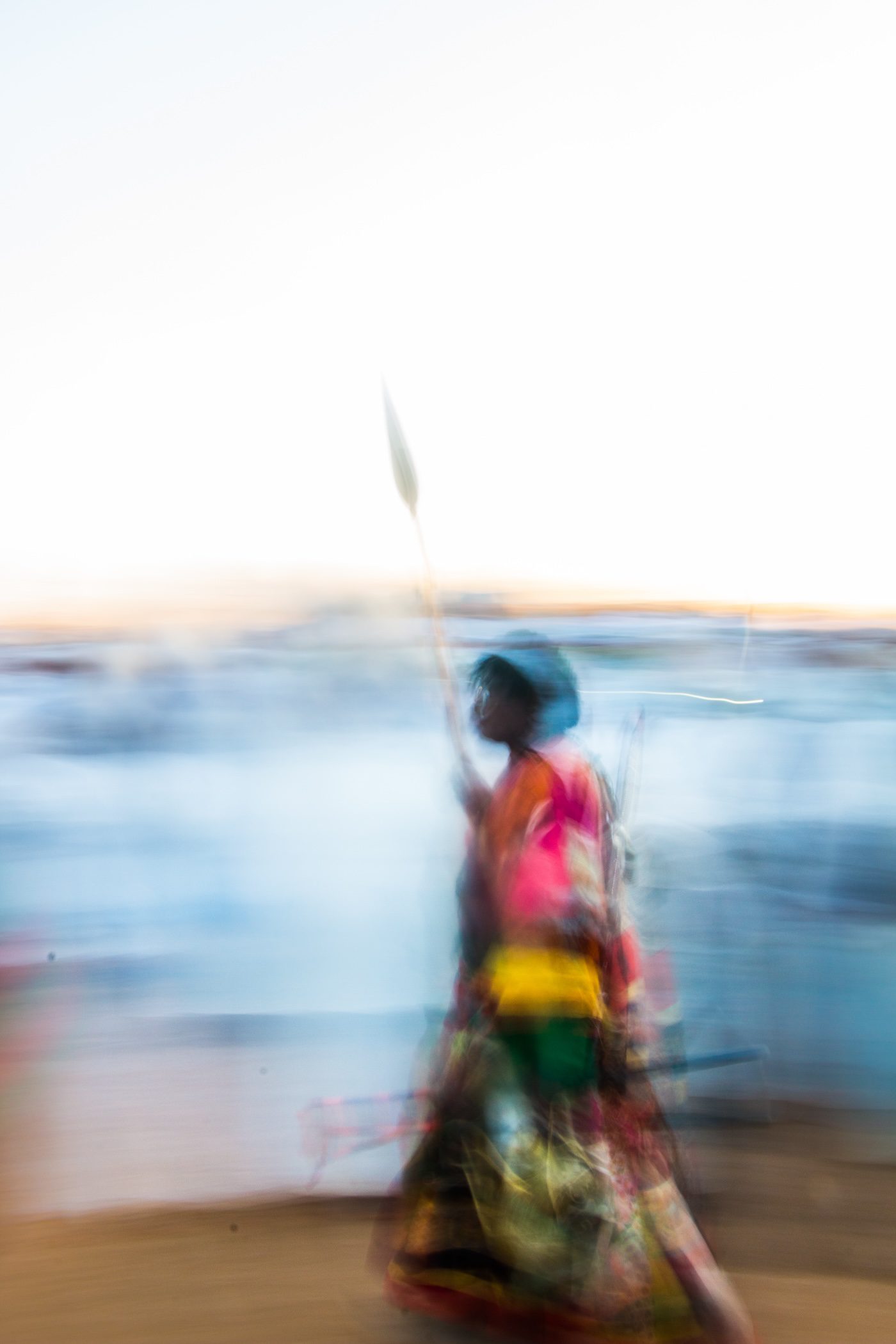Janka’s latest solo exhibition is a deeply personal journey into his spirituality, his closest friendship, and the circumstances of his life.

Elsadig Mohamed Janka, The Adoration, from Ahmed My Beloved series, 2016, Courtesy of Borderlands Art.
Elsadig’s work often explores place, and often references texts and imagery generated through collaboration. In his collaboration with researcher Nelly Caesar Arkangelo, titled We Miss Muniki, Elsadig reflects on the concepts of home and safety among displaced communities. The photographic series exhibited in Juba 2022 were taken from in and around Khartoum, the capital of Sudan, and draws inspiration from a famous song Juba by Mahmoud Abdelazez AKA Alhoot.

Elsadig Mohamed Janka, Haboba Maryam, from A House Away From Home series, 2024, Courtesy of Borderlands Art.
Elsadig’s Visions and Dreams, presented at the Kampala Art Biennale in 2016, was an installation of wallpaper, canvas, and text-covered surfaces throughout a room, combining short stories with photographs. It also included grouped household objects, such as a toilet seat, jerrycan, dustbin, broom, and ashtray, creating connections between fictional narratives and physical objects.
In the group exhibition City Remixing (Kampala, Uganda) organized by the archival website HIPUganda in Kampala in 2016, Elsadig and three other contemporary photographers explored historical and cultural aspects of photographic documentation of Uganda. The exhibition was a response to slides from the 1960s made by an engineer named M.W. Wambwa.
Walking Between Houses in 2015, was a collaboration between Elsadig Mohamed Janka and Andrea Stulteins, revisiting historical photographs to create new narratives: in this case, those taken by a Dutchman called Paul Julien during travels in Sudan between 1933 and 1948. Intertwining past and present, exploring the connections between people, places, and stories, Elsadig’s work referenced a Sudanese proverb that considered the in-between place as a source of knowledge.
In a recent conversation, Elsadig Mohamed discusses the dynamic movement of Al-Hadra rituals in relation to Islam and the daily ritualistic practices of spiritual communities. Ahmed My Beloved expands on the symbolism of Al-Hadra exploring its ability to bring together the experiences of the living across time and space.

Elsadig Mohamed Janka, The Friendship, from Ahmed My Beloved series, 2016, Courtesy of Borderlands Art.
Nantume Violet: The last time we communicated, you were Sudan. How is Khartoum?
Elsadig Mohamed: I have been based in Kampala for at least nine months or so. I’ve lived in Kampala before – between 2016 and 2018. I moved back recently when war broke out between the military of Sudan and the militia (The Rapid Support Forces RSF). Home in Khartoum was a war zone. Things quickly escalated in all regions. I now live in Muyenga, a suburb of Kampala, and I am working on a body of work for an upcoming group exhibition titled Send Me as well as a documentary film called The Camera Never Cries about a personal journey with documenting the sudanese revolution.
NV: You’ve committed a lot of time to developing technical filmmaking skills. Have you transferred these techniques to your photography?
EM: Definitely, as both are mediums for telling and reflecting feelings. A deep understanding of photography supports me as a writer and as a filmmaker and the other way around too, understanding of filmmaking feeds my photography.

Elsadig Mohamed Janka, Tanzeel, from A House Away From Home series, 2024, Courtesy of Borderlands Art.
NV: You have previously used photography as a tool to collect real-life intimate stories, more like a documentation tool. At what point did you come to use it more as an artistic medium to express these stories?
EM: I have a love-hate relationship with photography. I have jumped from photography to filmmaking and back. For a long while, photography was only a tool I used for research, to develop skills and a visual language for my cinematography. But it took me on a few journeys, away from filmmaking for a couple of years. The production costs of cinema are very different. Photography was the means by which I could keep working at all costs. I am still captivated by photography though; it has taken a long time for me to come back to film. I am now more interested in mixing documentary with an experimental style.
For the last five years I have been working on a documentary film about a cameraman I made friends with during the revolution [in Sudan in 2019] – about our journey as we tried to document the revolution. My several experiments with photography are coming in handy.

Elsadig Mohamed Janka, The Step, from Ahmed My Beloved series, 2016, courtesy Borderlands Art.
NV: Can you tell me about the photographs in Ahmed My Beloved?
EM: I made them between 2014 and 2016, in and out. I was trying different visual languages, moving between techniques to capture actual reality and dream reality. The straightforward documentary approach didn’t give me the feeling of my own understanding of the Sufi Al-hadra ritual – a sense of movement, spontaneity, simultaneity. I wanted to achieve an expression that was a mash-up, a mixture of everything within a single moment. In Al-Hadra, god is everything. So you are connecting with god through everything in the present, yet often we are captured by the past and future. I achieve this through techniques of multiple exposure and blurring. The images and sound were all collected from Sufi ceremonies held every Friday at the graveyard Halagat Zikr in Omdurman, where I grew up.
NV: You dedicate all the works made during several Halagat Zikr to a friend?
EM: Ahmed is my best friend. We met in secondary school. Ahmed studied engineering at Khartoum University and I was studying multimedia at Mashreq University. University was a whole new world for us – we were discovering new hobbies and we also wanted to do art; we were discovering the art scene and the art school. We created together and shared books. He also practiced guitar and painting. We wanted to do films together but he died before we could.
NV: The photographs have an important connection to your life and Ahmed’s.
EM: We both had the Sufi tradition in our families, in one way or another. Sufi ceremonies happened every Friday at Halagat Zikr. Ahmed didn’t live far from me, so each Friday we met up for breakfast at his home and then set off to the ceremony at 3 pm. The Sufi ceremony involves drumming, chanting, and procession. We had a lot of affinities to spirituality but we were also not considered proper Muslim. For both of us, the Sufi was the nicer part we discovered about Islam, where ideas of god and ideas of human beings didn’t feel restricted. In the Ahmed My Beloved exhibition, is also a collection of poems, mostly by Sufi sheiks or leaders from various generations, and a letter to Ahmed celebrating the moments we went Halagat Zirk together.

Elsadig Mohamed Janka, Uncle Salah, from A House Away From Home series, 2024, Courtesy of Borderlands Art.
NV: Shall we then say Sufi concepts are culturally rooted in Islam?
EM: In many parts of North Africa, Islam came through the sword, battles and fights. But in Sudan it came through Sufism, it came in a peaceful way. Sufism tried to adapt Sudanese culture to match the culture encountered. It spans a wide range of perspectives, but the part I care about most is introspection; looking towards yourself more than anything else – god is inside of you, from within you. A journey towards yourself.
NV: A journey towards oneself, you mean only internally?
EM: Yes. Even though I may have different feelings towards it now; more critical opinions. This period in my life was a specific step I took in discovering myself and where I was.
NV: What came first, the experience with the ceremony or the photography?
EM: When I started attending Sufi rituals, I hadn’t classified myself as a photographer. I was in my second year of university. Young people find their way through hobbies, and I was into film and writing scripts. Where I grew up, there were a lot of Sufi rituals all around and beyond us. In my neighborhood – Omudurman was another sheikh who held ceremonies every Wednesday, and I would pass by and see people chanting. A lot of friends had families who were into these practices; for example at weddings one would find Sufi rituals. It’s embedded in society.
At some point you open your eyes to really see what is around you. At the time I felt it was always very close, near to me, but I was not paying attention to it, except the few moments when I leaned in. This time, I was preoccupied with questions of; what Al-Hadra is, what Sufism is, what the idea of god is.

Elsadig Mohamed Janka, The Blessing, from Ahmed My Beloved series, 2016, Courtesy of Borderlands Art.
NV: A graveyard seems a strange place for ceremonies other than those connected directly to the dead.
EM: The Halagat Zikr in the middle of the graveyard is also known as the Hamadalneel graveyard, after a late prominent religious figure and Sufi leader. His tomb is located in the center of the graveyard, and surrounding it is an empty area where the Al-Hadra convocations take place. During these convocations, participants engage in chanting, swaying, and a Sufi dance. The powerful nature of the chanting sometimes affects individuals, causing them to trip and fall.
Al-Hadra rituals combine elements from various Sudanese traditional religions. Being open to everyone, Sufism has adapted and incorporated these elements from surrounding cultural practices. However, like many rituals, the Al-Hadraritual has certain codes and protocols that participants must observe to be in attendance.
NV: The crisis in Sudan has devastated your soul, your home…You return to Kampala under different circumstances than your first trip in 2016. How is Kampala? Do you plan to live there long term?
EM: I do not know. I am doing things, you know. I will stay and try to start a new life here. Who knows! The situation in Sudan might last a while. There is no clear plan really. The situation with my residency permit is precarious. I have to exit Uganda and come back every three months… I am also thinking about Kenya for that matter. For now, I have started a small restaurant here in Kabalagala. I am serving some Sudanese food like foul and tamiya, mullah and tabeekh. Fast food like kofta and shawarma
NV: So you can cook!
EM: Oh yes. I myself cooked. It was not until a few days ago, when I got a chef. It’s going somewhere. Slowly, slowly…
Elsadig Mohamed Janka is a Sudanese artist currently living and practicing in Kampala, Uganda. Born and raised in Omudurman, he graduated from Mashreq University in 2008. The artist’s nomadic narratives serve as reflective portals through which he interprets his ever-changing surroundings.
Nantume Violet is a curator and director at UNDER GROUND, a gallery and contemporary art space in Kampala, Uganda. She has worked as cultural producer for several years and has had collaborations in Eastern Africa, Ghana, South Africa, and Germany.
ON PHOTOGRAPHY
More Editorial